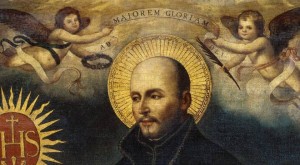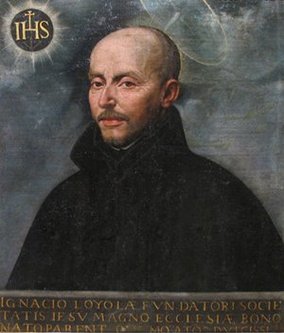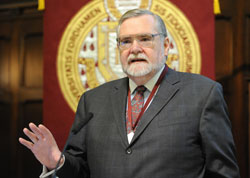The faithfulness to the spiritual patrimony one is raised on is an essential piece of understanding one’s own history and the grace that you’ve been given. That doesn’t mean, in my mind, that you can’t augment the first inspiration with another so you can round-out your life in a new way. Perhaps making the connection between Ignatian spirituality with that of the Benedictine charism. Pope Francis has done that in my mind. He’s faithful to Loyola’s Exercises and yet has an appreciation for many of the Carmelites. Here is the papal homily given earlier in Rome for the liturgical memorial of Saint Ignatius of Loyola, a man who’s path to be a soldier for Christ and His Church was started by a cannonball injury. Later, Ignatius set his eyes on the Lord by doing an extended retreat at the Benedictine Abbey of Montserrat. Recall, it is Ignatius experience with the monks that his conversion takes shape and does the Spiritual Exercises. You would do well to be attentive to the Pope’s quoting of the Spiritual Exercises. AMDG
 In this Eucharist in which we celebrate our Father Ignatius of Loyola, in light of the Readings we have heard, I would like to propose three simple thoughts guided by three expressions: to put Christ and the Church in the centre; to allow ourselves to be conquered by Him in order to serve; to feel the shame of our limitations and our sins, in order to be humble before Him and before the brothers.
In this Eucharist in which we celebrate our Father Ignatius of Loyola, in light of the Readings we have heard, I would like to propose three simple thoughts guided by three expressions: to put Christ and the Church in the centre; to allow ourselves to be conquered by Him in order to serve; to feel the shame of our limitations and our sins, in order to be humble before Him and before the brothers.
1. The emblem of us Jesuits is a monogram, the acronym of “Jesus, the Saviour of Mankind” (IHS). Every one of you can tell me: we know that very well! But this crest continually reminds us of a reality that we must never forget: the centrality of Christ for each one of us and for the whole Company, the Company that Saint Ignatius wanted to name “of Jesus” to indicate the point of reference. Moreover, even at the beginning of the Spiritual Exercises he places our Lord Jesus Christ, our Creator and Saviour (Spiritual Exercises, 6) in front of us. And this leads all of us Jesuits, and the whole Company, to be “decentred,” to have “Christ more and more” before us, the “Deus semper maior”, the “intimior intimo meo”, that leads us continually outside ourselves, that brings us to a certain kenosis, a “going beyond our own loves, desires, and interests” (Sp. Ex., 189). Isn’t it obvious, the question for us? For all of us? “Is Christ the centre of my life? Do I really put Christ at the centre of my life?” Because there is always the temptation to want to put ourselves in the centre. And when a Jesuit puts himself and not Christ in the centre, he goes astray. In the first Reading, Moses forcefully calls upon the people to love the Lord, to walk in His ways, “because He is your life” (cf. Deut. 30, 16-20). Christ is our life! The centrality of Christ corresponds also to the centrality of the Church: they are two flames that cannot be separated: I cannot follow Christ except in and with the Church. And even in this case we Jesuits and the whole Company, are not at the centre, we are, so to speak, “displaced”, we are at the service of Christ and of the Church, the Bride of Christ our Lord, who is our Holy Mother Hierarchical Church (cf. Sp. Ex. 353). To be men routed and grounded in the Church: that is what Jesus desires of us. There cannot be parallel or isolated paths for us. Yes, paths of searching, creative paths, yes, this is important: to go to the peripheries, so many peripheries. This takes creativity, but always in community, in the Church, with this membership that give us the courage to go forward. To serve Christ is to love this concrete Church, and to serve her with generosity and with the spirit of obedience.
2. What is the way to live this double centrality? Let us look at the experience of Saint Paul, which was also the experience of Saint Ignatius. The Apostle, in the Second Reading that we heard, writes: I press on towards the perfection of Christ, “because I have indeed been conquered by Jesus Christ” (Phil. 3:12). For Paul it came along the road to Damascus, for Ignatius in his house at Loyola, but the fundamental point is the same: to allow oneself to be conquered by Christ. I seek Jesus, I serve Jesus, because He sought me first, because I was conquered by Him: and this is the heart of our experience. But He is first, always. In Spanish there is a word that is very graphic, that explains this well: He “primerea” first ahead of us, “El nos primerea”. He is always first. When we arrive, He has already arrived and is expecting us. And here I want to recall the meditation on the Kingdom in the Second Week. Christ our Lord, the eternal King, calls each one of us, saying to us: “He who wants to come with Me must work with Me, because following Me in suffering, he will follow after Me likewise in glory” (Sp. Ex. 95): Being conquered by Christ in order to offer to this King our whole person and all our hard work (cf. Sp. Ex. 96); to say to the Lord that he would do anything for His greater service and praise, to imitate Him in bearing even injury, contempt, poverty (Sp. Ex. 98). But I think of our brother in Syria in this moment. To allow ourselves to be conquered by Christ means to be always directed towards what is in front of me, toward the goal of Christ (cf. Phil. 3:14), and to ask oneself with truth and sincerity: “What have I done for Christ? What am doing for Christ? What must I do for Christ?” (cf. Sp. Ex. 53).
3. And I come to the final point. In the Gospel, Jesus says to us: “Whoever would save his life will lose it, but whoever loses his life for my sake will save it . . . If anyone is ashamed of me . . .” (Lk 9:23). And so on. The shame of the Jesuit. The invitation that Jesus makes is for us to never be ashamed of Him, but to always follow Him with total dedication, trusting Him and entrusting ourselves to Him. But looking at Jesus, as Saint Ignatius teaches us in the First Week, above all looking at Christ crucified, we have that very human and noble feeling that is the shame of not reaching the highest point; we look at the wisdom of Christ and at our ignorance; at His omnipotence and our weakness; at His justice and our iniquity; at His goodness and our wickedness (cf. Sp. Ex. 59). Ask for the grace of shame; the shame that comes from the constant dialogue of mercy with Him; the shame that makes us blush before Jesus Christ; the shame that puts us in tune with the heart of Christ who is made sin for me; the shame that harmonises our heart in tears and accompanies us in the daily following of “my Lord”. And this always brings us, as individuals and as a Company, to humility, to living this great virtue. Humility that makes us understand, each day, that it is not for us to build the Kingdom of God, but it is always the grace of God working within us; humility that pushes us to put our whole being not at the service of ourselves and our own ideas, but at the service of Christ and of the Church, like clay pots, fragile, inadequate, insufficient, but having within them an immense treasure that we carry and that we communicate (2 Cor. 4:7). It is always pleasant for me to think of the sunset of the Jesuit, when a Jesuit finishes his life, when the sun goes down. And two icons of the sunset of the Jesuit always come to me: one classical, that of Saint Francis Xavier, looking at China. Art has painted this sunset so many times, this ‘end’ of Xavier. Even in literature, in that beautiful peace by Pemàn. At the end, having nothing, but in the sight of the Lord; it does me good to thing about this. The other sunset, the other icon that comes to me as an example, is that of Padre Arrupe in the last interview in the refugee camp, when he told us – something he himself said – “I say this as if it were my swan song: pray.” Prayer, the union with Jesus. And, after having said this, he caught the plane, and arrived at Rome with the stroke that was the beginning of so long and so exemplary a sunset. Two sunsets, two icons that all of us would do well to look at, and to go back to these two. And to ask for the grace that our sunset will be like theirs.
Dear brothers, let us turn again to Our Lady, to her who bore Christ in her womb and accompanied the first steps of the Church. May she help us to always put Christ and His Church at the centre of our lives and of our ministry. May she, who was the first and most perfect disciple of her Son help us to allow ourselves to be conquered by Christ in order to follow Him and to serve Him in every situation. May she that answered the announcement of the Angel with the most profound humility: “Behold the handmaid of the Lord, be it done unto me according to thy word” (Lk 1:38), make us feel the shame for our inadequacy before the treasure that has been entrusted to us, in order to live the virtue of humility before God. May our journey be accompanied by the paternal intercession of Saint Ignatius and of all the Jesuit saints, who continue to teach us to do all things “ad majorem Dei gloriam.”






